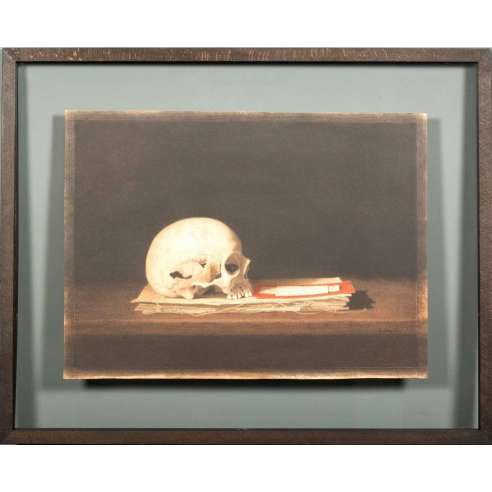Catherine Jansens’ watercolour titled "Vanitas" is a compelling still life that delves into the theme of the transience of life and the inevitability of death—an idea traditionally explored in the Vanitas genre of art. This work continues Jansens' exploration of memory, time, and the symbolism of everyday objects, as seen in her previous works.
The composition of "Vanitas" is meticulously arranged, with each element purposefully placed to convey a deeper narrative. Central to the composition is an array of objects that symbolize the passage of time and the ephemerality of human existence. These might include items such as a skull, a candle, a clock, or a decaying flower, though the specific objects in Jansens' version may vary. What ties them together is their symbolic weight—each object contributing to the overarching theme of life’s fleeting nature.
In the tradition of Vanitas paintings, these objects are not just randomly chosen but are carefully selected to remind the viewer of the impermanence of worldly pleasures and the certainty of death. The arrangement is likely simple yet powerful, with objects set against a dark background that heightens the sense of mystery and introspection.
Jansens employs a restrained color palette, dominated by muted earth tones and deep shadows. This use of color not only enhances the somber mood of the piece but also reflects the theme of decay and impermanence. The watercolor medium, with its ability to blend and create soft transitions, is expertly used to depict the delicate textures and subtle variations in light and shadow. Jansens’ experience with hyperrealism in oil painting translates into her aquarelle work, where she captures the finest details with precision, even within the softer and more ethereal medium of watercolor.
The contrast between light and shadow in "Vanitas" is particularly striking, a technique that Jansens uses to draw attention to specific elements within the composition, emphasizing their symbolic significance. The subtle gradation of colors and the careful handling of light create a sense of depth and realism, making the objects appear almost tangible, yet still shrouded in a sense of mystery.
"Vanitas" by Jansens is deeply rooted in the theme of mortality, a central concept in the Vanitas tradition. The objects depicted serve as reminders of life’s temporary nature and the futility of material wealth and achievements in the face of death. This theme is consistent with Jansens’ broader artistic exploration of memory and the passage of time, as seen in her other works like "Waterman."
By choosing to work in aquarelle, Jansens adds an additional layer of meaning to the piece. The watercolor medium, known for its fluidity and unpredictability, mirrors the theme of impermanence—just as watercolors can shift and change with the slightest touch, so too can life’s circumstances. This choice of medium, combined with the Vanitas theme, makes the work not only a visual representation of mortality but also a reflection on the transient nature of art itself.
Catherine Jansens' "Vanitas" is a masterful aquarelle that merges technical skill with profound thematic depth. Through her expert use of composition, color, and light, Jansens invites the viewer to contemplate the fleeting nature of life and the inevitability of death. The work is a continuation of her exploration into memory and time, using "found objects" and everyday items to create a narrative that resonates on both a personal and universal level. Jansens' "Vanitas" is a poignant reminder of the delicate balance between life and death, captured with the precision and emotional resonance that defines her artistic legacy.














